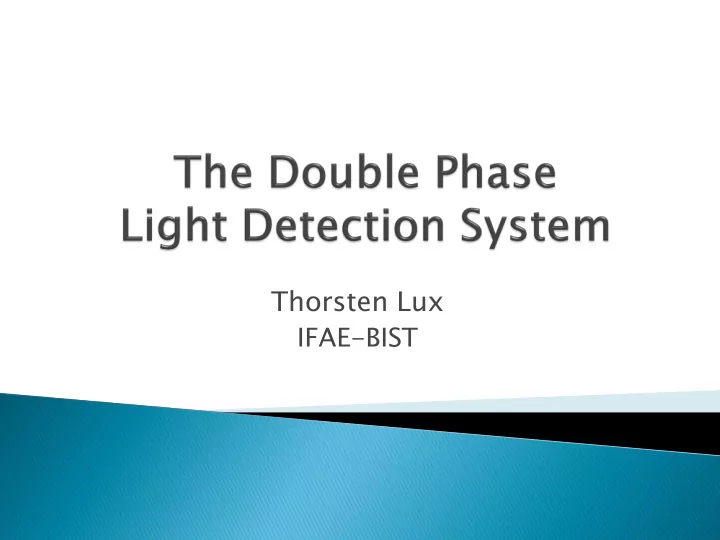

Thorsten Lux IFAE-BIST
Concept of the DP TPC Baseline Choice: PMTs 311 Prototype protoDune-DB/WA105 Alternative Light Readout R&D Conclusions 2
Anode (strips) 0V Collection field 5kV/cm 2 mm LEM/ GAr THGEM Extraction field 2-3kV/cm 1 cm LAr Grid Drift field 0.5 – 1 kV/cm 128 nm prompt e- 6 m light Cathode (~600 kV) Ligh ght t sensors ors (provide e t 0 ) CIEMAT (Madrid) IFAE (Barcelona) 3
• Model: R5912 from Hamamatsu • Suitable for LAr • Dynode stages: 10/14 • Gain: 10 7 /10 9 • Dark counts: 4000 cps • Diameter: 8” • Cathode coverage: ~3% 4
• PMTs not directly sensitive to 128 nm • TPB used for WLS • Thermal evaporation • 2 options for coating: TPB on acrylic plate TPB directly on PMT 5
Higher Qeff with direct coating but acrylic still fine and simpler => both tested in 311 prototype Setup at CERN used for characterization of both options First samples coated at CERN facility. 6
• Purpose: first tests of some design features of WA105 • Construction ongoing • Data taking starts in September 2016 7
5 PMTs: • 3 directly coated • 2 acrylic plate coatings 2 PMT bases tested: 8
6m 6m 6m 6m Some detector parameters 6m 6m • 8.3x8.3x8.1 m 3 total volume • Total mass: 705 tons • Active mass: 300 tons • 7680 charge readout channels • 36 PMTs (baseline: acrylic plate coating) 9
Characterization setup built at CIEMAT (Madrid/Spain) Gain vs HV HV Tests with all PMTs Dark k current t frequency Linearity (charge output vs light amplitude and frequency) “Light memory” - Response to the same light pulse after a previous variable light excitation. (With TPB) Spectral response at several points between 260nm and 400nm with LEDs or Xe lamp + monocromator and at 128nm with Ar and radioactive source.
Room temperature Linearity Gain vs HV LN2 temperature
Thin Films Depositi tion on system: Chamber: high 45 cm, : 30 cm. • Mechanical pump • Diffusion pump (High vacuum) • Vacuum meters: • - Pirani - Penning High intensity source • In situ thickness measurement • (quartz crystal microbalance) TPB Depositi tion on parameter ters: Technique: Thermal evaporation • Base pressure: < 5·10 -7 mbar • Substrates: glass and Acrylic (5 x 5 • cm).
• based on same technology as charge readout: TCA • cost-effective => scalable for DUNE • electr tron onics s outside side of cryosta stat • developed by LAPP- APC-OMEGA-IPNL • provides trigger for non-beam events 13
Cosmics are normally great for detector characterization but in for WA105 also a challenge .... ~10 kHz of cosmics ~40 cosmics overlapping in 4 ms readout window reconstruction of beam event a challenge dE/dx (MIP): ~2 MeV/cm 50.000 e/ions, 50.000 per cm 30 million e/ions and per MIP in 600 cm 14
• primary light has 2 components: ‐ fast component, singlet: 6 < < 18 ns ‐ slow component, triplet: ~1.6 s • 30 million photons for straight cosmic • most of light for MIPs in fast component => perfect for triggering But we have light background … 2 mm, 5 kV/cm 1 mm LEM, • electroluminescence (EL) in gas phase 35 kV/cm • each e- will produce some hundreds s 5 mm, 3 kV/cm • “constant” background 15
311 prototype type will provi vide de importa tant t inpu put Simulation Worse if N2 contamination! (A. Sokolov, MPGD2015) ppm level of N2: • reduces primary light peaks • increases EL induced background Not a proble lem for DUNE ... Underg rgro round und operatio ion n reduces ces cosmics cs by 10 4 to 10 5 ! ! 16
Setup Hamamatsu 3x3-50UM VUV3 Sample Gali S66 Amplifier (x6) 260 nm LED CAEN V965A QDC Tek DPO4104 Oscilloscope Tek AFG3252 Signal Generator Directly sensitive to 128 nm Dark Temp. Serial Vop Vop Coun unts Gain Coef efficien en N. N. (V) (kcps) t A0019 53.53 671 5.5E 56mV/C 17 6 A0020 53.63 607
1.0 1.0 Counts of A20 Counts of A20 0.9 0.9 T= 77K T= 298K Vop = 44.1V Vop = 53.63V 0.8 0.8 Led 260nm Led 260nm Gate 500 ns 1kHz 0.7 Gate 500 ns 1kHz 0.7 0.6 0.6 Counts Counts 0.5 0.5 0.4 0.4 0.3 0.3 0.2 0.2 0.1 0.1 0.0 0.0 30 35 40 45 50 55 60 65 32 34 36 38 40 42 44 46 48 50 52 54 56 58 60 Results Charge (pC) Charge (pC) Dark Dark Serial Vop Vop Serial Vop * Vop Coun unts Gain Coun unts Gain N. N. (V) N. N. (V) (cps) (cps) A0019 53.53 750k A0019 44.0 20 6.40E6 6.40E6 A0020 53.63 675k A0020 44.1 20 6.84E6 6.84E6 *The Temperature coefficient provided by Hamamatsu won’t work at 77K. Vop is an estimation so we have the same gain we have 18 at room temperature.
ETH Zurich Idea: Replace transpartent wire cathode by large acrylic plate coated with conductive ITO + TPB coating Pros: • no bubbles from PMTs • no light from space between cathode and PMTs Cons: • not cheap • many plates of <=1 m 2 => clueing them together and align them • effect of ions on TPB? 19
Tests ts in 1ton detec ector tor with larger er plates es and gluing g them m togeth ther will start t soon. 20
• Current baseline choice for WA105: PMTs + acrylic plates • Final decision after analysis of 311 prototype data • Characterization of all 40 PMTs for WA105 at room and LN2 temperature • LRO electronics development well advance and suitable also for DUNE • Surface operation of WA105 adds challenges to LRO • R&D on alternative LROs: • SiPM directly sensitive to 128 nm • SiPM coupled to WLS (to early to present results) • ITO+TPB coated cathode • Installation of PMTs in WA105: 10/2017 21
Recommend
More recommend